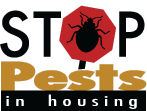Stinging Pests
How to deal with stinging pests
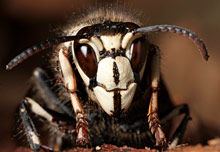 |
|
Bald-faced hornet. Photo by Gary Alpert, Env. Health & Safety, Harvard U. |
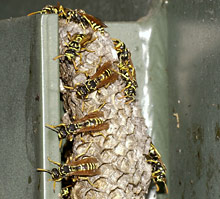 |
|
Paper wasps on nest. Photo by Gary Alpert, Env. Health & Safety, Harvard U. |
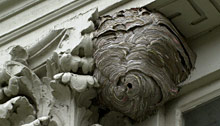 |
|
Wasp nest. Photo by Gary Alpert, Env. Health & Safety, Harvard U. |
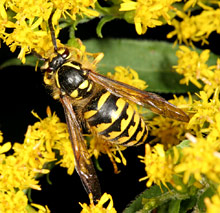 |
|
Yellowjacket. Photo by Gary Alpert, Env. Health & Safety, Harvard U. |
The best action is prevention. Scout from mid-spring on for small nests. Early on a chilly morning, before wasps have revved up for the day, knock down the nests with a pole, a strong jet of water from a hose, or even your kid’s super soaker—then step on the nest. If wasps set up shop too close to home (especially in wall voids) and you didn’t catch them early, hire a professional to remove the nest.
Before you start outdoor projects, check for nests in trees with holes in them, decks, railings, eaves, the undersides of outdoor furniture, and branches of trees and shrubs.
Have they joined your picnic? You are not their prey (unless you accidentally sit on one) so try not to swat them. Lures set far from your picnic table a few days before could help divert them. Cleaning up spilled sweets and keeping garbage cans away from tables will make your picnic area less attractive.
Mowing over a weedy area? When disturbed by a mower, ground-nesting wasps go into attack mode fast—so be careful. They’re more likely to nest in sandy soil and nests only get bigger as the season goes on.
A word about Cicada Killers
Although impressively large in size, Cicada Killers are non-aggressive wasps and prey upon cicadas. Males, which cannot sting, are the individuals most frequently seen, guarding the nest burrow opening. Females generally only sting when provoked. Children should be taught to not try and grab the insects. Using an over-the-counter wasp & hornet spray will not control wasps and larvae underground. It may also unnecessarily increase the risk of getting stung by provoking the females. If control is deemed desirable, it is best done by a professional. Cicada Killer activity is generally most pronounced in July and August. Since the wasps are attracted to disturbed, lightly vegetated soils, lawn practices that increase turf cover are the best long-term solutions.
What they look like
Most bees, wasps, hornets, and yellowjackets are either yellow and black or a shiny dark blue. All have four wings, and many have a narrow waist. Bees are furry, but wasps (including hornets and yellowjackets) usually look shiny. Not all stinging pests have wings. Furry caterpillars, for instance, could have stinging hairs that cause rashes or welts.
Where they live
Some species are loners. Others live in colonies in trees and stumps, the ground (especially sandy soil), the framing of your house or garage, or nests of paper or mud in a tree or under your eaves. If lots of them seem offended by your presence, there’s probably a nest nearby.
What they do
They sting . . . yet even so, they’re good to have around. They prey on garden pests and pollinate flowers. Unless someone nearby is allergic to bee or wasp stings, it’s best to keep your chemical control efforts to a minimum. (Some bee or wasp look-alikes don’t sting.)
Resources
See results from the Northeastern IPM Center’s resources database.
